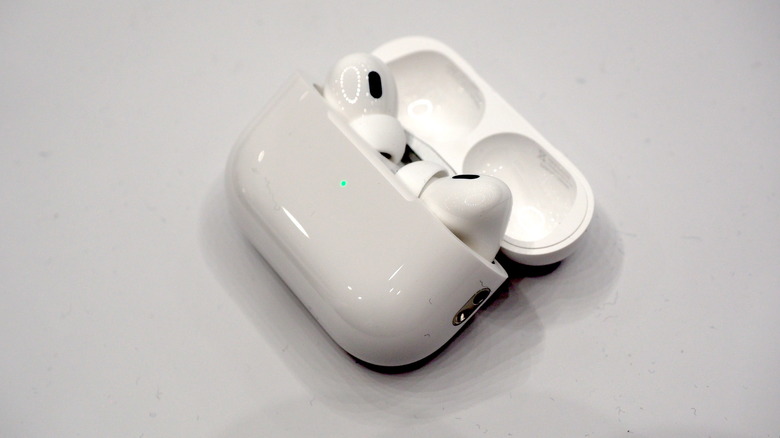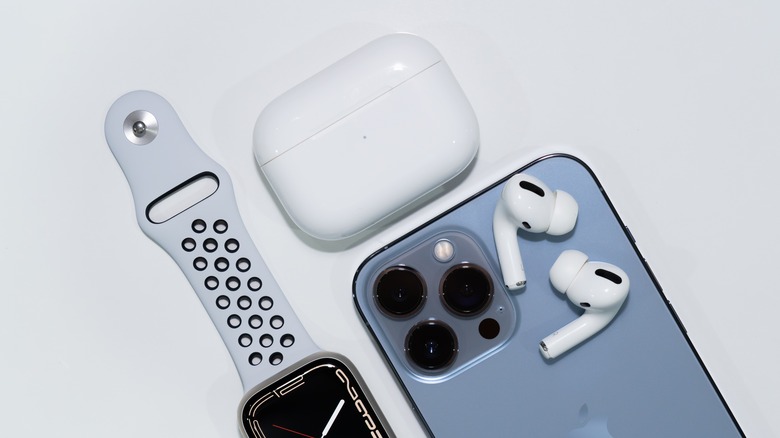How To Use Active Noise Cancellation On Your Apple AirPods Pro 2
Apple's AirPods Pro 2 brings a handful of new features and enhancements like improved sound quality and active noise cancellation, longer battery life, and a swipe gesture for volume controls. The case brings a number of improvements, as well, including Find My support with precise tracking, a speaker to help you find your case, built-in lanyard holes, and the ability to charge your AirPods case with an Apple Watch charger.
Active noise cancellation can be super handy, especially if you take the bus or train to work or are a frequent flyer, as being able to tune out the world around you can come in clutch in those environments. Likewise, having the ability to turn on Transparency mode and quickly hear an announcement or have a quick conversation with someone is very useful. And now with the new model, you can ignore everyone around you for even longer periods of time thanks to the six-hour battery with active noise cancellation turned on, as we explained in our AirPods Pro 2 review.
How to turn on AirPods Pro 2 active noise cancellation
Using ANC on AirPods Pro is pretty straightforward. The earbuds will be in ANC mode when you first put both in your ears straight out of the box. When you take one AirPod out of your ear, however, the other earbud will enter what's called Transparency mode. As Apple points out in its support document, in this mode, AirPods will use its microphones to let you hear the world around you without having to completely remove them.
By default, the AirPods Pro will toggle between ANC mode and Transparency mode when you press and hold the sensor on the stem. You'll hear two distinct chimes when switching between the two modes. You can also toggle ANC modes through your iPhone. First, you'll want to make sure your AirPods are in your ears and paired to your iPhone. From there, do the following:
- Activate Control Center by swiping down from the top right corner (if you have an iPhone with Face ID) or by swiping up from the bottom (if your iPhone has Touch ID).
- Press and hold the volume widget.
- Tap Noise Control.
After performing those steps, you'll be given three options: Noise Cancellation, Off, and Transparency. The middle "Off" toggle turns off both ANC and Transparency mode, leaving the user with only passive noise isolation.
How to customize the tap and hold gesture on the AirPods Pro 2
As we mentioned above, there are three modes your AirPods can go in: ANC, Transparency, and Off. By default, pressing and holding the stem will switch between ANC and Transparency mode. But if you'd like, you can have your AirPods switch between all three, any combination of the three, or you can completely reprogram it to trigger Siri instead (via Apple). This works on both 1st and 2nd generation AirPods Pro.
To do this, make sure your AirPods Pro is paired with your iPhone. Here's what you want to do after that:
- Head to Settings > Bluetooth.
- Find your AirPods Pro on the list and tap the "i" icon next to it.
- From there, tap Left or Right under "Press And Hold AirPods." You can set these independently or the same, depending on your preference.
- Select which modes you want your AirPods to switch to.
- Repeat the process for your other AirPod.
Sadly, you can only have Noise Control or Siri control per earbud, not both. Of course, you can choose Noise Control for your left AirPod, and Siri for your right AirPod if you'd like. Just keep in mind that you can also activate Siri by saying, "Hey Siri."
How to tell if active noise cancellation is working
Now that you know how to activate ANC, here are a few ways you can tell if whether active noise cancellation is enabled. The most obvious way to check is to put both AirPods Pro earbuds in your ears; if you can hardly hear anything around you, it's enabled. This isn't always a given though, because ANC and Transparency modes sound very similar when you're in a quiet room. If you suspect ANC isn't working on your AirPods Pro, you may want to make sure earwax or debris isn't building up on the earbuds' mesh (via Apple). If you need to clean the AirPods, we have a guide on how to safely do so.
Another way to check whether ANC is enabled is directly on your iPhone. With the AirPods paired to it, do the following:
- Activate Control Center by swiping down from the top right corner (if you have an iPhone with Face ID) or by swiping up from the bottom (if your iPhone has Touch ID).
- Press and hold the volume widget.
- Tap Noise Control.
From there, your iPhone will tell you if you're in Noise Cancellation, Off, or Transparency mode. Of course, you can toggle yourself into the ANC mode in this menu if it's not already enabled. If you don't want to mess with software, another thing you can do is tap and hold the stem. The AirPods Pro makes two distinct chimes when switching between Transparency and ANC modes. When going from ANC to Transparency mode, you'll hear two high-pitched tones in succession. While going from Transparency to ANC mode, you'll hear one deeper chime.
How AirPods Pro active noise cancellation works
There's nothing inherently special when it comes to how the AirPods Pro handles active noise cancellation versus its competitors. The model works by having outward-facing microphones listen to the world around you and essentially playing the opposite sounds to you through your ears. There's also a microphone facing inward toward the user that listens for sounds in the ear canal, as well, according to Apple. This causes the two sounds to cancel each other out, effectively creating that noise-canceling effect (via Hear Life).
You may then ask the question: why choose the AirPods Pro 2 over the first-generation AirPods Pro? That's a valid question. While the basic premise of active noise cancellation is the same, it can be improved upon. According to Apple, the second-generation model has two times the active noise cancellation of the first-generation model, plus the stem now has touch controls that allow users to adjust the volume.
The AirPods Pro 2 also features the H2 chip, which is a big upgrade over the H1 found in the first-gen model. That chip is credited with the longer battery life offered by the newer model, as well as with improvements to 3D sound and the addition of Adaptive Transparency. That latter feature uses the H2 chip to automatically adjust the level of audio delivered while in Transparency mode, hopefully resulting in a more comfortable experience.




